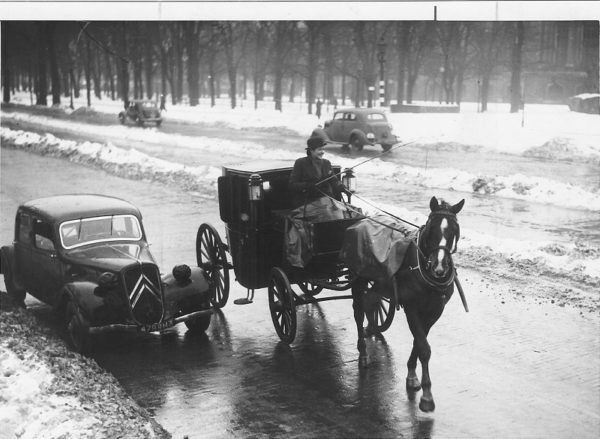
We know that wartime privations often led owners of motor cars to resort to other sources of fuel when petrol was in short supply. However, what we see here seems to be the even more radical – but entirely practical – solution provided by a totally different form of motive power.
The blackout covers on this Citroën Traction Avant clearly indicate that the image dates from the years of the Second World War – and the location looks very likely to be the Avenue des Champs-Élysées in Paris. The female driver of the horse-drawn carriage is definitely pleased with her solution to the problems of wartime transport.
The question then remains the precise date. The German army occupied Paris in June 1940, and the vehicle travelling in the other direction could possibly be a German army staff car, such as an Opel Kadett.
Fortunately, as so often is the case with such images, the reverse gives us more information. It is stamped with the date 28 February 1942. A little bit of research into the weather during that year tells us that the 1942 winter was the coldest since 1895, which certainly seems to explain the snow.
Turning now to the car: the Traction Avant was a ground-breaking design, introduced in 1933 and designed for André Citroën by engineer André Lefèbvre and designer Flamino Bertoni, to meet his desire to create a totally new concept. He specified a 100 km/h maximum speed, a consumption of 10 litres / 100 km, uni-body construction and front-wheel drive – and despite several technical problems the car delivered. Road-holding was described as outstanding.
During World War II the Tractions were favoured by the French Resistance because of this remarkable agility – but sadly many of the cars perished during the exploits of these brave individuals.
Production restarted fully in 1946 and lasted until 1957. The last Traction, an 11CV Familiale, was delivered on 25th July 1957, and therefore overlapped by nearly two years the production of yet another ground-breaking Citroën – the immortal DS, introduced on 5th October 1955 at the Paris Salon. The 15/6H Traction, one of the last versions of the Traction, had self-levelling hydraulic rear suspension and acted as a test-bed for the revolutionary hydro-pneumatic suspension of the DS. A 15/6H was used by the actor Rupert Davies in the British TV series of Maigret that ran from 1960 to 1963.
We can only guess what the Traction in our picture was doing there on that chilly day in 1942. Out of fuel, simply parked, or waiting for something more adventurous and more dangerous?







Leave a Comment